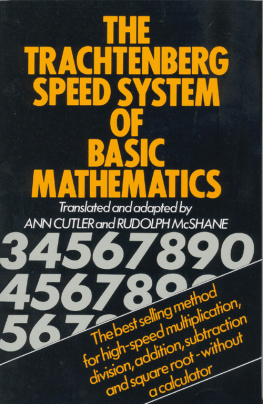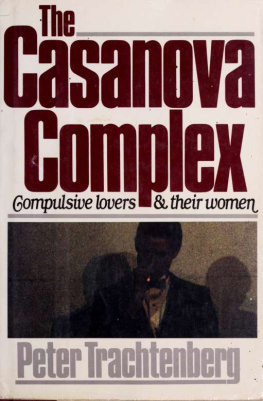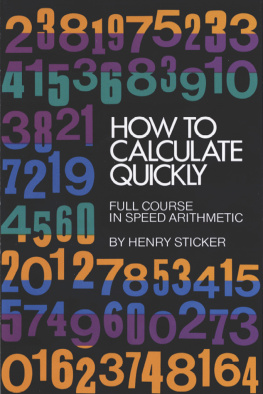
Contents
ONE:
TWO:
THREE:
FOUR:
FIVE:
SIX:
SEVEN:
EIGHT:
The teacher called on a nine-year-old boy who marched firmly to the blackboard upon which was a list of numbers a yard long. Standing on tiptoe to reach the top, he arrived at the total with what seemed the speed of light.
A small girl with beribboned braids was asked to find the solution of 735352314 times 11. She came up with the correct answer8088875454in less time than you can say multiplication table. A thin, studious-looking boy wearing silver-rimmed spectacles was told to multiply 5132437201 times 452736502785. He blitzed through the problem, computing the answer2323641669144374104785in seventy seconds.
The class was one where the Trachtenberg system of mathematics is taught. What made the exhibition of mathematical wizardry more amazing was that these were children who had repeatedly failed in arithmetic until, in desperation, their parents sent them to learn this method.
The late Jakow Trachtenberg, founder of the Mathematical Institute in Zurich, Switzerland, and originator of the startling new system of arithmetic, was of the firm opinion that everyone comes into the world with phenomenal calculation possibilities.
The Trachtenberg method is not only speedy but simple. Once one has mastered the rules, lightning calculation is as easy as reading a story. It looks like magic, but the rules are based on sound logic.
Trachtenberg, a brilliant engineer with an ingenious mind, originated his system of simplified mathematics while spending years in Hitlers concentration camps as a political prisoner. Conceived in tragedy and amidst brutal hardships, this striking work cannot be separated from the life of its originator for it is quite possible that had Professor Trachtenbergs life run a more tranquil course he might never have conceived the system which has eliminated the drudgery so often associated with arithmetic.
The life of Trachtenberg is as fascinating and astounding as his brilliant mathematical system which many experts believe will eventually revolutionize the teaching of arithmetic in schools throughout the world.
A Russian, born in Odessa, June 17,1888, Jakow Trachtenberg early showed his genius. Graduating with highest honors from the famous Berginstitut (Mining Engineering Institute) of St. Petersburg, he entered the world-renowned Obuschoff shipyards as a student-engineer. While still in his early twenties, he was named Chief Engineer. In those Czar-ruled days, there were ambitious plans to create a superlative navy and 11,000 men were under Trachtenbergs supervision.
Though he headed the Obuschoff shipyards, Trachtenberg was a dedicated pacifist. At the outbreak of World War I he organized the Society of Good Samaritans which trained Russian students to care for the woundeda work which received special recognition from the Czar.
The murder of the imperial family in 1918 put an end to the Russian dream of a grandiose navy. It also ended Trachtenbergs personal hope of a happy, peaceful life. Hating brutality and violence, Trachtenberg became their victim.
As the revolutionaries swept right across Russia, Trachtenberg spoke out fearlessly against the savagery and lawlessness. The criticism imperiled his life. Early in 1919, he learned that he was slated to be murdered. Dressed as a peasant, walking at night, hiding out through the day, he made his way into Germany.
Berlin, with its beautiful wide streets, its cold, sparkling, weather, reminded him of St. Petersburg and became his home. In a tiny room at an unpretentious address, he started life anew and made friends with the bitter, disillusioned young intellectuals of the postwar era. He became their leader. As the editor of a magazine, he often spoke for this group when he urged Germany towards a future of peace.
Trachtenberg married a beautiful woman of the aristocracy. His reputation grew as he wrote a number of critical works on Russia and compiled the first reference book on Russian industry. He was looked upon as Europes foremost expert on Russian affairs. His inventive mind set itself another task. He devised a method of teaching foreign languages which is still used in many German schools.
The upheaval of his early years seemed to have been left behind. But with the coming of Hitler, Trachtenbergs life once more took on the familiar pattern of strife. Courageously, he spoke out against fascism. Trachtenbergs reputation was such that Hitler at first chose to overlook his attacks. But when Trachtenbergs accusations grew more pointed, Hitler marked him for oblivion.
In 1934, knowing if he remained in Germany he would be liquidated, Trachtenberg once more fled for his life. Accompanied by his wife, he escaped to Vienna where he became editor of an international scientific periodical.
While the world was preparing for war, Trachtenberg, to further the cause of peace, wrote Das Friedensministerium (The Ministry of Peace), a widely read work which brought him the plaudits of such statesman as Roosevelt, Masaryk, and Van Zeeland.
But all over the world peace was dying. The Germans marched on Austria. Trachtenbergs name headed Hitlers most-wanted list. He was seized and thrown into prison.
He managed to escape to Yugoslavia where he and his wife, Countess Alice, lived like hunted animals, rarely venturing out during the day, making no friends or acquaintances. But his freedom was brief. He was awakened one night by the heavy pounding of fists on the doorthe Gestapo was calling. Hitlers men had caught up with him.
He was shipped in a cattle car to a concentration campone noted for its brutality. The slightest variance from the rules resulted in outrageous forms of punishment. Daily the ranks of the prison were decimated by the ruthlessly random selection of victims for the ovens.
To keep his sanity, Trachtenberg moved into a world of his owna world of logic and order. While his body daily grew more emaciated, and all about him was pestilence, death, and destruction, his mind refused to accept defeat and followed paths of numbers which, at his bidding, performed miraculous feats.
He did not have books, paper, pen, or pencil. But his mind was equal to the challenge. Mathematics, he believed, was the key to precise thinking. In happier times, he had found it an excellent recreational outlet. In a world gone mad, the calm logic of numbers were like old friends. His mind, arranging and re-arranging, found new ways of manipulating them.
He visualized gigantic numbers to be added and he set himself the task of totaling them. And since no one can remember thousands of numbers, he invented a fool-proof method that would make it possible for even a child to add thousands of numbers together without making a mistake-without, in fact, ever adding higher than eleven.
During his long years in the living hell of the concentration camp, every spare moment was spent on his simplified system of mathematics, devising shortcuts for everything from multiplication to algebra. The corruption and misery, the cries from clammy cells and torture chambers, the stench of ovens, the atrocities, and the constant threat of death, faded as he doggedly computed mathematical combinationsreckoning rules, proving and proving again, then starting over again to make the system even simpler.
The hardships acted as a spur to his genius. Lacking paper, he scribbled his theories on bits of wrapping paper, old envelopes, the backs of carefully saved German work sheets. Because even these bits of paper were at a premium he worked everything in his head, putting down only the finished theories.
Next page





